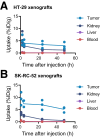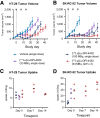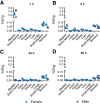Preclinical Characterization of DPI-4452: A 68Ga/177Lu Theranostic Ligand for Carbonic Anhydrase IX
- PMID: 38514083
- PMCID: PMC11064828
- DOI: 10.2967/jnumed.123.266309
Preclinical Characterization of DPI-4452: A 68Ga/177Lu Theranostic Ligand for Carbonic Anhydrase IX
Abstract
The membrane protein carbonic anhydrase IX (CAIX) is highly expressed in many hypoxic or von Hippel-Lindau tumor suppressor-mutated tumor types. Its restricted expression in healthy tissues makes CAIX an attractive diagnostic and therapeutic target. DPI-4452 is a CAIX-targeting cyclic peptide with a DOTA cage, allowing radionuclide chelation for theranostic purposes. Here, we report CAIX expression in multiple tumor types and provide in vitro and in vivo evaluations of 68Ga-labeled DPI-4452 ([68Ga]Ga-DPI-4452) and 177Lu-labeled DPI-4452 ([177Lu]Lu-DPI-4452). Methods: CAIX expression was assessed by immunohistochemistry with a panel of tumor and healthy tissues. The molecular interactions of complexed and uncomplexed DPI-4452 with CAIX were assessed by surface plasmon resonance and cell-binding assays. In vivo characterization of radiolabeled and nonradiolabeled DPI-4452 was performed in HT-29 colorectal cancer (CRC) and SK-RC-52 clear cell renal cell carcinoma (ccRCC) human xenograft mouse models and in healthy beagle dogs. Results: Overexpression of CAIX was shown in several tumor types, including ccRCC, CRC, and pancreatic ductal adenocarcinoma. DPI-4452 specifically and selectively bound CAIX with subnanomolar affinity. In cell-binding assays, DPI-4452 displayed comparably high affinities for human and canine CAIX but a much lower affinity for murine CAIX, demonstrating that the dog is a relevant species for biodistribution studies. DPI-4452 was rapidly eliminated from the systemic circulation of beagle dogs. The highest uptake of [68Ga]Ga-DPI-4452 and [177Lu]Lu-DPI-4452 was observed in the small intestine and stomach, 2 organs known to express CAIX. Uptake in other organs (e.g., kidneys) was remarkably low. In HT-29 and SK-RC-52 xenograft mouse models, both [68Ga]Ga-DPI-4452 and [177Lu]Lu-DPI-4452 showed tumor-selective uptake; in addition, [177Lu]Lu-DPI-4452 significantly reduced tumor growth. These results demonstrated the theranostic potential of DPI-4452. Conclusion: DPI-4452 selectively targets CAIX. [68Ga]Ga-DPI-4452 and [177Lu]Lu-DPI-4452 localized to tumors and were well tolerated in mice. [177Lu]Lu-DPI-4452 demonstrated strong tumor growth inhibition in 2 xenograft mouse models. Thus, the 2 agents potentially provide a theranostic approach for selecting and treating patients with CAIX-expressing tumors such as ccRCC, CRC, and pancreatic ductal adenocarcinoma.
Keywords: 177Lu; 68Ga; CAIX; dog; mouse.
© 2024 by the Society of Nuclear Medicine and Molecular Imaging.
Figures







References
-
- Karhumaa P, Kaunisto K, Parkkila S, et al. . Expression of the transmembrane carbonic anhydrases, CA IX and CA XII, in the human male excurrent ducts. Mol Hum Reprod. 2001;7:611–616. - PubMed
Publication types
MeSH terms
Substances
LinkOut - more resources
Full Text Sources
Other Literature Sources
Miscellaneous
